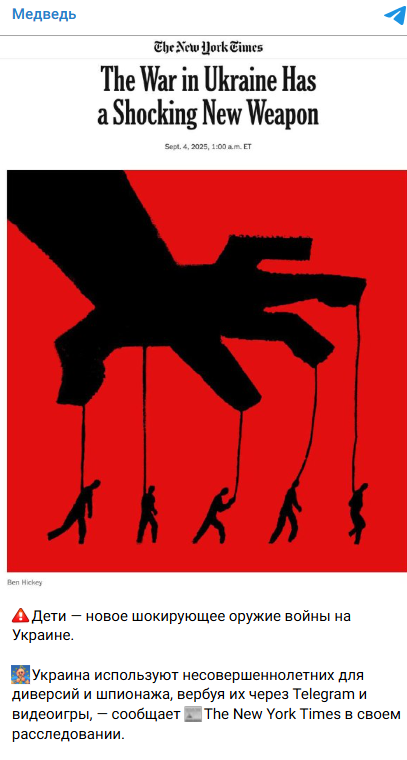Verification within Meta’s Third-Party Fact-Checking Program
Russian sources, citing an article from The New York Times, are spreading information claiming that Ukraine recruits minors for sabotage and espionage through Telegram and video games. Recruitment methods are described as cruel: from promises of easy money to blackmail with intimate photos.
However, this is manipulation. The article states that both sides resort to recruiting minors using similar methods. 
Screenshot of the post
On September 4, The New York Times published an article by Lilia Yapparova, a Russian journalist from the opposition media outlet Meduza, under the headline “The War in Ukraine Has a Shocking New Weapon.” It says that since the beginning of the full-scale invasion, both sides — Ukraine and Russia — have used children to carry out sabotage on enemy territory.
Lilia Yapparova is a special correspondent for Meduza. In the first days of Russia’s full-scale invasion, she came to Ukraine and prepared reports about the war. In particular, she wrote about crimes committed by Russians in the Kyiv region in 2022 and about Russia’s recruitment of mercenaries for the war in Ukraine.
For this, intelligence services contact teenagers through messengers or video game chats, offering quick earnings. After establishing contact, the curators provide instructions. Tasks vary: from taking photos of police cars or ambulances to spraying toxic substances in a school. The article says that both Ukrainian and Russian intelligence services sometimes resort to blackmailing children with intimate photos.
In particular, the National Police reported that Russians forced a 14-year-old girl from Ternopil to commit a terrorist act by blackmailing her with explicit pictures. At the same time, there is no information in open sources about similar actions by Ukrainian intelligence services.
The article adds that Russians sometimes go even further and resort to killing the teenagers they recruited. For example, in March 2025, Russian intelligence blew up two of their own agents — Ukrainian boys aged 15 and 17 — who were carrying an improvised explosive device near a railway station to carry out a terrorist attack. One of them died on the spot, and the other had both legs amputated.
The author notes that since spring 2024, the Security Service of Ukraine (SBU) has arrested about 175 minors involved in espionage, arson, and explosions organized by Russian intelligence officers. Russia does not provide similar official statistics, but human rights activists interviewed by the journalist reported at least 100 such cases. At the same time, Russian teenagers engaged in subversive activities are brutally punished. The article, in particular, describes a boy who set fire to railway equipment and a train compartment. Russian police beat him with electric shockers for so long that the devices kept running out of charge. The material does not mention similar actions by Ukrainian law enforcement officers.
